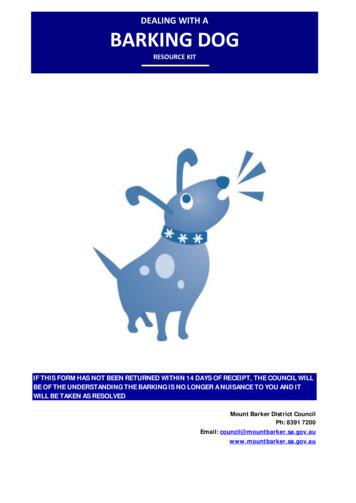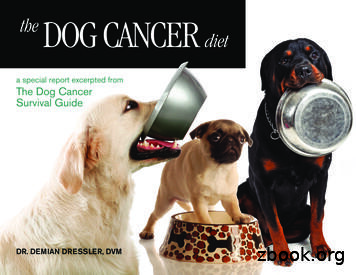ARE YOU VACCINATING YOUR DOG TOO MUCH?
ARE YOU VACCINATINGYOUR DOG TOO MUCH?A QUICK GUIDE TO COMPARING YOUR DOG’SVACCINE SCHEDULE TO CURRENT RESEARCH.1
It’s recently been reported by the senior brand manager ofBoehringer Ingelheim that the majority of vets are vaccinatingmore often than necessary. Unnecessary vaccines place yourdog at unnecessary risk for vaccine related health issues. Thisquick guide will help you decide if your dog is being vaccinatedmore often than research shows is necessary.2
Quick HistoryIn the 1970s, all vaccines, with the exception of rabies vaccines, were licensed bythe United States Department of Agriculture (USDA) based on challengestudies performed for just a few weeks to a few months after vaccination.All the vaccine labels included the statement ‘‘Annual Revaccination Recommended’’ without really knowing whether the true duration of immunity (DOI)was a year or a lifetime. So vets vaccinated yearly, even though field observationsuggested that immunity after both natural infection and vaccination was longlived.In the mid 1970’s, veterinary immunologist Dr Ronald Schultz and his cohortsquestioned this and began researching how long vaccines really lasted.3
“My interest in vaccine DOI(duration of immunity) wasstimulated by several factors .Says Dr Schultz124The observation that dogs who had recoveredfrom canine distemper and cats who had recovered from panleukopenia were completely resistant to experimental viral challenge many yearslaterThat my three children were receiving a series ofvaccinations that would end about the time theyentered school with most of the vaccines neverbeing given again3A veterinarian in the US Army Veterinary Corpsasked me to design a vaccination program for dogsand cats that did not require yearly revaccinations4It was not known if yearly vaccinations were necessary for dogs and cats, but most experts I consulted believed they probably were not needed.
Research was initiated at this time to prove Dr Schultz’s suspicions anddogs were challenged with exposure to distemper, adenovirus and parvovirus, anywhere from 1 to 11 years after vaccination.THE RESULTS:Every single dog was protected when exposed to the virus.Based on this research, Dr Schultz andScott recommended triennialrevaccination (every three years)instead of annual revaccination.5group ofdeitmliisthmofr“The resultse Nordenthdteatrsnomeddogs clearlyed immuidvorpseinccavemodified livst CDVinagasraey11tsanity for at levovirus)”ra(p-2VPCdna)(distemper- Dr Schultz
. The AAHA Vaccine Guidelines Are CreatedThese early recommendations prompted the American Animal Hospital Association (AAHA) toassemble a task force. In 2003, the AAHA Canine Vaccine Task Force evaluated the data from thesechallenges and serological studies and, while noting that the core vaccines had a minimum duration of immunity of at least seven years, compromised in 2003 with thisstatement:Task force member Dr Richard Ford, Professor ofRevaccination everyMedicine, North Carolina State University, said that3 years is consideredthe decision to recommend a 3 year revaccinationprotective.schedule for core vaccines was a compromise.“”“IT’S COMPLETELY ARBITRARY” HE SAID. “I WILL SAY THERE ISNO SCIENCE BEHIND THE THREE-YEAR RECOMMENDATION ”6
After the 2003 task force, all of the major veterinary vaccine manufacturers completed theirown studies showing a minimum three year duration of immunity on the core vaccines -distemper, parvovirus and adenovirus.YTINUMMIGNOLIFELNEVPRODr Schultz continued with his work and by 2006, had completed several additional studieson over 1,000 dogs and repeated the same results over and over again, effectively showing that dogs were protected for much longer than three years and most likely for the lifeof the dog.In fact, so sure was Dr Schultz of his work, that his own vaccination protocol for his dogswas one shot of distemper, parvovirus and adenovirus and none thereafter.7
THARGYHAIR LOSS, HAIR COLORCHANGE AT INJECTION SITEFEVERSORENESSSTIFFNESSREFUSAL TO EATCONJUNCTIVITISSNEEZINGORAL ULCERSIMMUNOSUPRESSIONBEHAVIORAL CHANGESVITILIGOWEIGHT LOSS (CACHEXIA)REDUCED MILK EDEMAATOPYRESPIRATORY DISEASEALLERGIC UVEITIS (BLUE EYE)ANAPHYLAXISARTHRITIS, POLYARTHRITISIMMUNE MEDIATED THROMBOCYTOPENIAHEMOLYTIC DISEASE OF THENEWBORNTHYROIDITISGLOMERULONEPHRITISDISEASE OR ENHANCED DISEASE WHICH WITH THE VACCINEWAS DESIGNED TO PREVENTMYOCARDITISPOST VACCINAL ENCEPHALITISOR POLYNEURITISSEIZURESABORTION, CONGENITALANOMALIES, EMBRYOIC/FETALDEATH, FAILURE TO CONCEIVEThe risks of vaccination (why you don’twant to give any more vaccines than necessary)- From Schultz , 2007
In 2011, the AAHA updated their Canine Vaccination Guidelines once moreto “every 3 years or more” with the following comment:“Among healthy dogs, all commercially available [core] vaccines areexpected to induce a sustained protective immune response lasting atleast 5 yr. thereafter”But despite their recommendation of no more than every three years, the AAHATask Force admitted vets that vaccines protect for a much longer period of time .9
“This is supported by a growing body of veterinaryinformation and well-developed epidemiologicalvigilance in human medicine that indicates immunityinduced by vaccination is extremely long lasting and,in most cases, lifelong.As Dr Ford stated, compromises areclearly being made, judging by theAAHA’s arbitrary and slow-to-evolverevaccination recommendations.”What could be holding the AAHAback from making stronger statements and why don’t they enforcethese guidelines?The AAHA is sponsored by four vaccine manufacturers: Merck,Merial, Pfizer and Boehringer Ingelheim. Furthermore, the veterinary members of the task force certainly have a vested financialinterest in how often vaccines can be delivered.10
. Is this a potential conflict of interest and could this create biasin the task force recommendations?Regardless,60% of vets todaystill vaccinate moreoften than theAAHA guidelines11So 60% of vets are vaccinating three times more often than theircollege recommendations . which already encourageover-vaccination and ignore current research.
If there was any scientific precedent for revaccination, theAAHA’s careful and gradual move away from this annualvaccination would be understandable.But the only research behind vaccines shows a duration ofimmunity of at least seven years for the core vaccines there is and never has been any evidence tothe contrary.12
MINIMUM DURATION OF IMMUNITY FORCANINE VACCINESDISTEMPER 7 years by *challenge / 15 years by *serologyPARVOVIRUS 7 years by *challenge / 7 years by *serologyADENOVIRUS 7 years by *challenge / 9 years by *serologyCANINE RABIES 3 years by *challenge / 7 years by *serology* CHALLENGE is immunity proven by exposing dogs to the disease.* SEROLOGY is immunity proven by high levels of protective antibody.13
“Vaccines for diseases like distemper andcanine parvovirus, once administered toadult animals, provide lifetime immunity.”“Are We VaccinatingToo Much?- Concludes Dr. SchultzJAVMA, No. 4, August 15,14”
As dog owners – the people who are financially and emotionally responsible forthe effects of over-vaccination – we deserve better than this. Until the AAHAstops compromising and catches up to current vaccine research, the mostimportant compromise could be our dogs’ health and welfare.In the meantime, Dr Schultz’s research shows that over 95% of puppiesvaccinated at 16 weeks of age or later will be protected FOR LIFE.15
FROM THE AAHA GUIDELINES:“Because dogs older than 14–16 wk of age are not likely to have interfering levels of MDA*, administration of a single initial dose of an infectiousvaccine to an adult dog can be expected to induce a protective immuneresponse. The administration of a single, initial dose of infectious vaccineto dogs 16 wk of age is considered protective and acceptable.”* Maternally derived antibodies, which are passive immunity the mother dog passes to her puppies.16
“ The truth is the majority of vets are not going tochange until they are forced to – which is not likely tohappen due to politics and due to the lack of concernby the one entity that could protect the public andensure animal welfare: the individual state veterinarymedical boards .”Says Dr Patricia Jordan17“This change willhave to come fromthe public, they haveto stop allowing theover servicing.”
Are You Vaccinating Too Often?This is where you come in. You can protect your dog from theharm unnecessary vaccines can cause. Use the chart on thenext page determine how many more vaccines than DrSchultz’s scientifically proven schedule your dog is getting.18
GUIDE TO VACCINATION SCHEDULESPUPPIESADULT DOGS(NUMBER OF VACCINES*)SCIENTIFICALLYPROVEN SCHEDULE(BASED ON RONALD SCHULTZ’SBODY OF RESEARCH2011 AAHAGUIDELINES“VACCINES ARE EXPECTED TOINDUCE A SUSTAINED PROTECTIVEIMMUNE RESPONSE LASTING ATLEAST 5 YR.”ANNUALVACCINATION(REPORTEDLY PERFORMED BY 60%OF ALL PRACTICING VETS(NUMBER OF VACCINES*)1 3 3 Given at 16 weeksTiter 3 weeks afterEvery 3 - 4 weeksbetween 8 and 16weeks of ageEvery 3 - 4 weeksbetween 8 and 16weeks of age(NUMBER OF VACCINES*)0 1 05 8 515 18 Lifelong ImmunityGiven at 1 yearEvery 3 years afterGiven at 1 yearEvery year after*Based on a 15 year old dog19UNNECESSARYVACCINES*TOTAL“A practice that was started many years ago and that lacks scientific validity or verification is annual revaccinations.Almost without exception there is no immunologic requirement for annual revaccination.” Dr Ronald SchultzPuppy shots followedby every 3 yearsPuppy shots followedby every yearNo shots requiredafter 16 weeks15No shots requiredafter 16 weeks
Nearly thirty years after Dr Schultz’s initial research, the AAHA failed torecognize the long lasting immunity the core vaccines could provide andmerely changed their revaccination recommendations from “revaccination every 3 years is considered protective” to “revaccination every 3years or more is considered protective.”Today, Dr Schultz continues with his research and his results are repeated time and time again. In the meantime, research is increasingly showing the harmful effects of vaccines and this has notescaped the AAHA’s notice.Check out page 8 to see a list of common to severe reactions.20
WWW.DOGSNATURALLYMAGAZINE.COM21
The AAHA Vaccine Guidelines Are Created These early recommendations prompted the American Animal Hospital Association (AAHA) to assemble a task force. In 2003, the AAHA Canine Vaccine Task Force evaluated the data from these challenges and serological studies and, while noting that the core vaccines had a min-
L’ARÉ est également le point d’entrée en as de demande simultanée onsommation et prodution. Les coordonnées des ARÉ sont présentées dans le tableau ci-dessous : DR Clients Téléphone Adresse mail Île de France Est particuliers 09 69 32 18 33 are-essonne@enedis.fr professionnels 09 69 32 18 34 Île de France Ouest
If the dog is barking at people it can see passing by, try blocking the dog's view. An anti-barking collar may be useful for some, but not all. Teach the dog to stop barking on command. When the dog is barking give a firm command such as 'cease' and call the dog to you. Praise the dog when it stops barking. If the dog will not .
the dog barking, try some of these simple tips - every dog is different! Do not reward the dog when it barks. Don't let the dog inside or give it attention - instead, reward the dog when it is quiet. Teach the dog to stop barking on command - give the dog a command when it is barking and reward the dog
The Bird Dog stories describe the adventures of a boy and a dog. The dog learns to hunt birds so the boy calls the dog a bird dog. A girl, a boy riding a bike, and some other animals, joins the boy and dog. They go hunting for all kinds of creatures, including a cat and skunk. The bird dog is a good hunter except for hunting boys and girls.
the DOG CANCER diet 1 Did you know you can help your dog fight cancer at his next meal? The right foods - many of which you probably have in your house right now - can be powerful weapons for a dog with cancer. Putting your dog on a Dog Cancer Diet, as outlined in this report, accomplishes two things. The Dog Cancer Diet: 1. Fights Cancer.
2. The handler does not present the area to the dog resulting in the aid not being located by the dog. Security Dog Misses: The security dog does not show any change of behaviour or interest to the source aid odour when the area is presented by the handler. Security Dog Walk: The security dog shows a change of behaviour, works the source .
Canine Wisdom for the Barking Dog-The Dog Done Gone Deaf is a spin-off, a twist, an amalgamation that takes its cue from the eponymous album The Dog Done Gone Deaf by Halim El-Dabh, which he performed with The Barking Dog Sextet for the Suoni Per Il Popolo Festival in Montreal, Quebec in 2007. The Dog Done Gone Deaf seems to me an appropriate
13. What are your dog's favorite toys (if interested in toys)? 14. Is your dog sensitive about any parts of his/her body touched (i.e., tail, paws, etc.)? Boarding Information 15. Has your dog ever boarded overnight anywhere before? If yes, explain how they did there. 16. Do you ever (or have you ever) used a crate/kennel at home for your dog?























